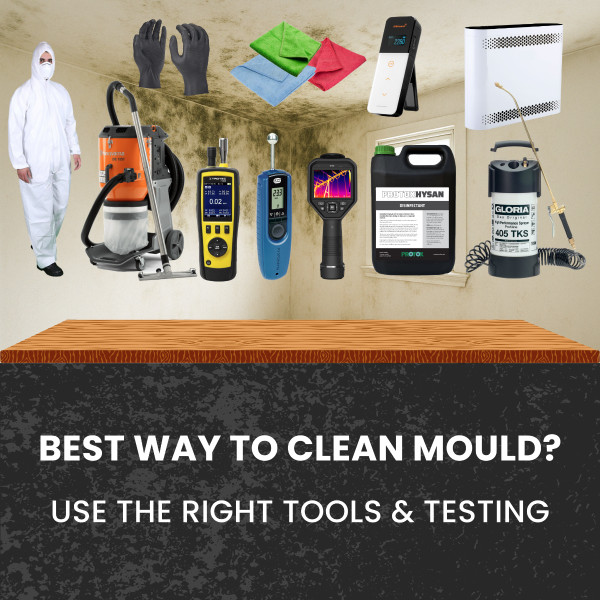Best Way to Clean Mould? Use the Right Tools & Testing
In restoration, time is money—and nothing costs you more than ineffective mould remediation.
Professional mould removal isn’t just chemicals and a HEPA vacuum. It’s about smart choices: putting the right products together, using the right techniques, and saving time and money without sacrificing results.
Let’s walk through the smarter approach that delivers results your and your customers can trust—and keeps your business thriving.
Understanding the Real Problem: Mould Isn’t Always "Alive"
Traditionally, mould cleaning has leaned heavily on ATP hygiene testing—checking for the presence of living contamination (adenosine triphosphate). But mould doesn’t have to be alive to cause health problems. Dead mould, debris, and fragments can still trigger allergic reactions and respiratory issues.
That’s where A3 testing offers a game-changing advantage.
Unlike basic ATP surface testing, A3 testing measures ATP (living) and AMP/ADP (dead biological material).
- ✅ ATP Testing: Detects live biological contamination.
- ✅ A3 Testing: Detects both live and dead biological contamination—giving a clearer, more complete picture.
When you use A3 testing, you look for more than just visible or living contaminants. You find all harmful residues. This makes your mould treatment process more complete and easier to defend.
Additional Testing Options
A3 hygiene testing is a quick way to find mould issues. However, there are other types of mould testing. The choice depends on the job, client needs, or insurance rules. These traditional methods often involve lab analysis and provide deeper diagnostic information when needed.
These include:
- Mould Swabs – Collect samples from small surfaces for lab analysis.
- Mould Tape Sampling – Ideal for visible mould on walls or hard surfaces; tape is pressed against the surface and sent to a lab.
- Bulk Sampling – Involves cutting out a piece of material (e.g., gyprock) for lab testing.
- Air Sampling – Measures airborne spore levels to assess contamination and effectiveness of remediation.
While valuable, these tests can be time-consuming, costly, and often involve delays while waiting for lab results. That’s why integrating A3 hygiene testing into your standard process gives you a critical advantage.
The Right Workflow for Effective Mould Remediation
Here’s the smarter, more efficient step-by-step process restoration professionals should follow to get rid of mould:
Step 1: Identify the Problem
Use tools like:
- Moisture meters to find hidden water sources.
- Particle counters to detect airborne contamination levels. Understand why mould is present before you start fixing it.
Step 2: Containment
Prevent cross-contamination by sealing off the mouldy area with proper containment systems, zip walls, and negative air setups.
Step 3: Air Management & Material Removal
- Set up HEPA-filtered air filters to manage airborne particulates.
- Remove unsalvageable materials carefully to avoid disturbing spores.
Step 4: HEPA Vacuum All Surfaces
HEPA vacuuming removes loose mould spores, dust, and debris from surfaces before cleaning with product. Make sure your vacuum is H13 rated.
Step 5: Apply Mould Removal or Cleaning Product
One of our best products, Protox Hysan Stabilised Chloride Dioxide (ClO2) is your powerful yet safe mould removal product.
On gyprock walls with condition 2 mould:
- Apply Protox Hysan ClO2 to the affected area using the Duo Mop.
- Agitate lightly with a soft broom.
- Reapply Protox Hysan ClO2 using the Duo Mop to lift and rinse the surface.
On timber framing:
- Foam the Protox Hysan ClO2 onto surfaces using a Gloria Foam Sprayer.
- Agitate with soft brushes.
- Spray again to rinse—no second vacuuming or wiping needed.
Protox Hysan ClO2 is a free-rinsing product.
It doesn't leave residue, unlike many traditional chemicals that could create future problems by leaving sticky surfaces that trap dust and particles.
Why Product Synergy Matters: Save Time, Improve Results
Choosing the right combination of professional mould removal products, consumables, and PPE means:
- ✅ Faster cleaning with fewer steps – Protox Hysan ClO2 removes the need for separate rinsing.
- ✅ More accurate validation – A3 testing confirms both live and dead contaminants are handled.
- ✅ Healthier environments – Protects technicians and building occupants long-term.
Must-Have Products for Professional Mould Removal
Here’s what should be in your kit:
Mould Cleaning Products
- Protox Hysan ClO2– Professional mould, bacteria, and virus disinfection.
- Gloria Sprayers & Foamers – High-quality, durable sprayers for applying detergents and disinfectants with precision.
Hygiene Validation
- Kikkoman Lumitester Smart with A3 Testing – For complete live and dead biological residue detection.
PPE
- Respirators (Full face)
- Disposable Coveralls (microporous to prevent dust penetration)
- Gloves (nitrile or chemical resistant)
- Shoe covers to prevent spreading spores to clean areas.
- Knee Pads for technician comfort in low-clearance areas.
Consumables
- HEPA-rated Vacuums
- Microfibre Cloths for damp wiping after vacuuming
- Disposable Wipes for easy, hygienic surface cleaning
- Tape, Zipper, Plastic and Containment Poles for setting up containment zones
All these parts work together to give you the fastest, cleanest, and most professional results. This also helps lower your cost per job and reduce risk.
Why Investing in the Right Process Pays Off
- ✅ Save Time: Streamlined techniques and free-rinsing products like Protox Hysan ClO2 mean quicker, simpler cleaning.
- ✅ Lower Costs: No need to buy multiple types of cleaners. Less PPE and fewer consumables used thanks to smarter containment and workflow.
- ✅ Protect Technicians and Clients: Minimise exposure to chemicals, spores, and allergens with effective PPE and less abrasive cleaning methods.
- ✅ Win More Jobs: Insurance companies and property managers like companies that prove their results with A3 testing. They also prefer clean, residue-free environments.
- ✅ Build Reputation: Clients love a remediator who can prove surfaces are safe—not just guesswork.
Effective mould remediation today isn’t just about wiping away stains. It's about:
- Understanding both live and dead contaminants through A3 hygiene testing.
- Using smart, free-rinsing products like Protox Hysan ClO2
- Equipping your team with the best sprayers, PPE, and containment setups.
- Saving your business time, money, and future call-backs.
The combination of smart technology, professional mould removal products, and refined techniques makes all the difference between surviving in restoration—and thriving.
Recent Posts
-
Ten Years of Restore Solutions: Innovation for Restorers
In 2015, Restore Solutions entered the market with one clear purpose — to help restoration professio …2nd Dec 2025 -
The Ultimate Battery Operated Power Scrubber for Restoration Professionals
Less Elbow Grease, More Results: Meet the Battery-Powered Scrubber That Does the Hard Work for You S …17th Nov 2025 -
Choosing the Right Cleaning Chemicals in Restoration: Work Smarter, Work Safer
Chemical safety isn’t an optional extra in restoration — it’s the foundation of professional, consis …9th Nov 2025




